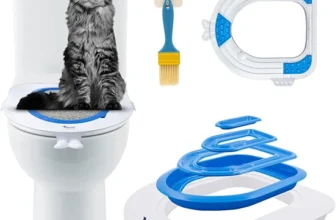Socialization training is essential for ensuring your American Wirehair cat is well-adjusted and happy, but it can be a challenging process. As a cat owner, it can be tough to know where to start and what to avoid. Rushing the process, punishing your cat, exposing them to too much too soon, and neglecting socialization altogether are common mistakes. This article will explore these mistakes in detail and provide practical tips to ensure your American Wirehair receives proper socialization training. Let’s dive in and discover how to avoid these pitfalls and improve your cat’s socialization journey.
Mistake 1: Rushing the Process

Take your time and go at your cat’s pace when socializing them. Rushing the process of socialization can be detrimental to your cat’s ability to adjust to new experiences and environments. It’s important to be patient and take things slow to prevent overwhelming your American Wirehair kitten or cat. Gradually introduce them to new people, places, and activities, rewarding good behavior along the way. Don’t forget to allow your cat time to relax and retreat to a safe space if needed. For more information on American Wirehair kitten socialization, check out /american-wirehair-kitten-socialization/.
Not Taking It Slow
Taking things slow is a crucial aspect of American Wirehair socialization training. Rushing can cause your kitten to become overwhelmed, anxious, and even fearful of new people or environments. It’s important to remember that socialization is a process, not an event, and it takes time and patience.
To ensure that you don’t rush the process, try following a socialization plan or utilizing a socialization checklist. This will help you keep track of what new experiences your kitten has been exposed to and what areas still need attention. Additionally, don’t move onto the next step of socialization until your kitten is completely comfortable with the current level.
Another tip for taking it slow is to gradually introduce your kitten to new people and environments. Start with quiet environments with minimal distractions and slowly build up to more stimulating places. The same goes for introducing new people: start with one person at a time and gradually introduce your kitten to larger groups.
Remember to reward good behavior and give your kitten time to relax and unwind between socialization sessions. Don’t force your kitten to continue socializing if they seem overwhelmed or stressed – it’s important to listen to your kitten’s signals and body language.
For more information on socialization techniques, check out our article on socialization techniques for shy American Wirehair cats.
Not Gradually Introducing New People and Environments
One of the most crucial aspects of American Wirehair socialization training is gradually introducing new people and environments to your kitten. Cats, especially young ones, can feel overwhelmed in new situations, which can lead to stress and undesirable behavior.
To ensure a positive socialization experience, you should gradually expose your American Wirehair to new people and environments in a calm and controlled manner. Consider introducing one new element at a time, such as a new person or a new room in your home.
Be patient and give your kitten time to adjust to the new environment or person. This may take several visits or interactions before your kitten feels comfortable. You can encourage positive behavior by rewarding your kitten with treats, toys, or affection when they exhibit calm and relaxed behavior.
It’s also important to make sure your kitten has a safe space to retreat to if they feel overwhelmed or anxious. This can be a cozy bed or a small room where they feel secure. Always watch your kitten’s body language, such as flattened ears or a puffed-up tail, to make sure they are not feeling stressed or fearful.
By gradually introducing your kitten to new people and environments, you can help them become well-adjusted and confident cats. For more tips on socializing your American Wirehair, check out our article on American Wirehair Kitten Playtime Socialization.
Not Rewarding Good Behavior
When training your American Wirehair, rewarding good behavior is just as important as correcting bad behavior. Unfortunately, some pet owners make the mistake of neglecting to reward their cat for doing something right. This can be detrimental to the socialization process, as your cat may not understand what it’s doing that is considered good behavior.
To avoid this mistake, make sure to reward your cat with treats, toys, or affection when he or she responds positively to socialization training. For example, if your Wirehair Kitten displays good behavior around new people or animals, give them a treat as a reward. This will not only encourage your cat to continue the good behavior but also associate socializing with positive experiences.
Rewards can be especially useful when you’re introducing your Wirehair Kitten to new environments or household items. Suppose your cat reacts positively to a new toy or piece of furniture. You should encourage your cat by giving them a reward to reinforce the good behavior. This will help your cat to become more confident and feel more comfortable around unfamiliar objects.
To make sure that your cat understands what behavior is considered positive, use a training strategy called positive reinforcement. This involves rewarding good behavior as soon as it happens so that your cat knows exactly what they did right. Additionally, you can use verbal praise or clicker training to reinforce good behavior.
Rewarding good behavior is a crucial part of socialization training. Not only does it encourage your Wirehair Kitten to continue positive behavior, but it also makes socializing a positive experience. By using positive reinforcement techniques, you can help your cat become a happy and well-adjusted pet.
Not Giving Your Cat Time to Relax and Unwind
When it comes to socializing your American Wirehair, it’s important to remember that your cat needs time to relax and unwind during the process. Without giving your cat adequate time to rest, you risk overstimulating them, which can result in negative behaviors down the line.
Why is it important to give your cat time to relax and unwind? Just like humans, cats can become overwhelmed and stressed out if they are constantly in new and stimulating environments. In order for your cat to process all of the new experiences they are having during socialization training, it’s important to give them time to rest and recuperate. This will help them feel more comfortable and confident in their new surroundings, which will ultimately make the socialization process go more smoothly.
How can you give your cat time to relax and unwind? There are several things you can do to help your cat relax during socialization training. First, make sure to give your cat breaks in between training sessions so they have a chance to rest and recharge. Additionally, provide your cat with a safe and comfortable space where they can retreat to if they feel overwhelmed. This could be a cozy cat bed or a quiet room where they can take a nap. Finally, be sure to give your cat plenty of praise and positive reinforcement during socialization training – this will help boost their confidence and make them feel more at ease.
It’s important to remember that socialization training is a marathon, not a sprint. By giving your cat time to relax and unwind, you’re helping to ensure that they have a positive and successful experience. So be patient, take your time, and give your furry friend all the love and support they need along the way.
If you want more information about socializing American Wirehair kitten with other pets, you can check our article “How to Socialize Your American Wirehair Kitten with Other Pets”.
Mistake 2: Punishing Your Cat

It is imperative to keep in mind that punishing your American Wirehair during socialization training can have serious consequences and is a common mistake that many cat owners make. While it may seem like the quickest way to correct your cat’s behavior, it can lead to negative associations with the training process and ultimately backfire. Instead of punishing your cat during training, it is crucial to focus on positive reinforcement and addressing any underlying behavioral issues. It is easy to get frustrated with your cat’s progress, but it is important to remember that training takes time and patience. Let’s take a closer look at some specific mistakes to avoid when it comes to punishing your American Wirehair during socialization training.
Physically Punishing Your Cat
Physically punishing your cat is one of the common mistakes that people make during the American Wirehair socialization training. This can include hitting, kicking, or even using tools such as spray bottles or shock collars. However, physical punishment can cause more harm than good and can actually make your cat more fearful and aggressive.
Here are some reasons why physically punishing your cat during socialization training is not recommended:
- Punishment can lead to fear and anxiety
- Your cat may associate the punishment with the training itself
- Your cat may become more aggressive or even retaliate in response to physical punishment
- Physical punishment can damage your relationship with your cat and lead to mistrust
Instead of physical punishment, it’s important to use positive reinforcement and rewards to encourage good behavior. This can include treats, praise, and playtime. If your cat is exhibiting unwanted behavior, such as scratching or biting, it’s important to redirect their attention and provide them with appropriate toys and scratching posts.
If you’re struggling with aggression or other behavioral issues during socialization training, it’s important to seek professional help from a veterinarian or animal behaviorist. They can provide you with the tools and strategies you need to properly socialize your American Wirehair and address any underlying behavioral issues.
For more information on socializing your American Wirehair with children, check out our article on Wirehair Kitten Socializing with Children. And, if you’re dealing with aggressive behavior during training, be sure to read our article on Aggressive Behavior in American Wirehair Training.
Yelling or Shaming Your Cat
When it comes to American Wirehair socialization training, yelling or shaming your cat can be one of the biggest mistakes you can make. For starters, yelling at your cat can actually do more harm than good. According to veterinary experts, cats have much better hearing than humans, so yelling can actually cause your cat to become stressed and scared. Instead of yelling, try using a calm and assertive tone of voice to get your point across.
Another thing to avoid is shaming your cat. Your cat will not understand what they have done wrong, and may become fearful or anxious as a result. Shaming your cat is a form of punishment that can cause long-term damage to your cat’s mental health. It’s important to remember that positive reinforcement is much more effective than punishment when it comes to training your cat.
If your cat is exhibiting unwanted behavior, it’s important to address the underlying issue. For example, if your cat is scratching your furniture, provide them with a scratching post or pad as an alternative. This will give your cat an appropriate outlet to scratch and discourage them from scratching your furniture.
Here are some other tips to help positively reinforce good behavior in your cat:
– Offer treats and praise when your cat displays good behavior. This will encourage your cat to repeat that behavior in the future.
– Redirect your cat’s attention when they are engaging in undesirable behavior. For example, if your cat is scratching your furniture, redirect their attention to a toy or food puzzle.
– Use clicker training to teach your cat new behaviors. Clicker training is a positive reinforcement method that involves using a clicking sound to indicate to your cat that they have performed a desired behavior, followed by a reward.
– Be patient and consistent in your training efforts. Remember that training takes time, and it’s important to be consistent in your approach. With patience and consistency, you can help your American Wirehair become a well-socialized and well-behaved companion.
Not Addressing Underlying Behavioral Issues
It’s a common mistake to punish your American Wirehair cat for unwanted behavior without actually addressing the underlying behavior issues. This can lead to your cat feeling anxious and stressed, which ultimately worsens their behavior. It’s important to understand why your cat is behaving a certain way and address those underlying issues.
Here are some underlying behavioral issues you should focus on when addressing your American Wirehair cat’s behavior:
- Anxiety: Your cat may be displaying undesirable behavior due to anxiety caused by a lack of stimulation or over-crowded living conditions. To help them feel more comfortable, provide them with a space of their own and interactive toys.
- Medical problems: It’s possible that there might be an underlying medical issue causing your cat’s behavior. Consult with your veterinarian to rule this out.
- Environmental triggers: Sometimes, your cat’s behavior may be influenced by external factors, such as loud noises. Identifying and addressing these triggers can help prevent unwanted behavior.
- Past experiences: If your cat has had traumatic experiences in the past, they may be displaying unwanted behavior as a result. Providing them with a safe, secure environment can help them feel more comfortable.
By addressing these underlying behavioral issues, you can help your American Wirehair cat feel more comfortable and happy, which in turn will lead to better behavior. Remember, punishment alone is not sufficient to train your cat to behave properly.
Not Providing Alternatives to Unwanted Behaviors
When you punish your American Wirehair for unwanted behaviors during socialization training, it’s crucial to provide alternative behaviors for them to engage in. Simply punishing them without providing an alternative will leave them confused and frustrated, which can lead to more behavioral issues. Here are some alternatives to negative behaviors that you might encounter during socialization training:
Scratching Furniture: Provide a scratching post or mat for them to use instead of your furniture. Encourage them to use it consistently by rewarding them when they do.
Biting or Scratching Hands: Provide a toy or other object for them to redirect their energy towards. You can also teach them commands like “no bite” and “gentle” to help them understand what behaviors are appropriate.
Jumping on Countertops: Provide a designated surface or perch for your American Wirehair to sit on instead of jumping on your countertops. Reward them when they use it appropriately.
Fearful Behavior: If your cat is showing signs of fear or anxiety during socialization training, provide a safe space like a crate or hiding spot where they can retreat and feel secure. Also, consider using pheromone sprays or diffusers to help calm their nerves.
By providing alternatives to unwanted behaviors, you’re not only preventing negative behaviors, but you’re also promoting positive behaviors that will help your American Wirehair become a confident and well-socialized cat.
Mistake 3: Exposing Your Cat to Too Much too Soon

When it comes to socializing your American Wirehair, it’s important to strike the right balance between exposure and overwhelm. While it’s crucial to introduce your cat to new environments, people, and animals, overstimulation can quickly backfire and lead to fear and anxiety. So, how do you know when you’re crossing the line? Here, we’ll discuss common mistakes that pet owners make in this area and provide tips for avoiding them. Let’s dive in.
Taking Your Cat to Overstimulating Environments
Overstimulating environments can be extremely overwhelming for your American Wirehair cat. It is important to gradually introduce your cat to new environments and stimuli while being mindful of their reactions. Here are some common mistakes to avoid when introducing your cat to new environments:
- Exposing your American Wirehair to loud noises: Sudden and loud noises like fireworks, blaring music, or noisy gatherings can be stressful and frightening for your cat.
- Overcrowded spaces: If your cat is not used to being around a lot of people or animals, suddenly taking them to a crowded space like a park or pet store can be overwhelming. It is important to gradually expose your cat to more individuals and animals to ease them into socialization.
- Exposure to strong smells: Your cat’s sense of smell is their most powerful sense. Exposure to strong and new smells, like perfume, cigarette smoke or cooking aromas can stress out your cat.
- Unfamiliar and busy surroundings: New places with unfamiliar surfaces, sounds and sights can be stressful for your American Wirehair cat.
If your cat is showing signs of discomfort or anxiety in any of these situations, it is best to remove them from the situation and provide them with a safe and quiet environment. By gradually exposing your cat to new environments and stimuli, and keeping a watchful eye on their reaction, you can help your American Wirehair enjoy new experiences and socialize properly. Remember to provide positive reinforcement with treats and praise to encourage good behavior.
Overwhelming Your Cat with Many New People or Animals
Bringing your American Wirehair cat to a gathering or introducing them to other animals can be overwhelming for them. Overwhelming your cat with too many new people or animals at once is one of the common mistakes to avoid during American Wirehair socialization training. This could lead to stress, anxiety, and fear.
To prevent overwhelming your cat in such situations, you can take the following measures:
- Introduce fewer people or animals at once: When introducing your cat to new people or animals, start with one or two, and gradually increase the number over time.
- Provide a safe space: Create a safe space for your cat where they can retreat if they feel uncomfortable. This can be a room with their bed, toys, and litter box.
- Monitor your cat’s body language: Pay attention to your cat’s body language and behavior. Signs of stress or fear include flattened ears, wide eyes, dilated pupils, and hissing or growling. If you notice any of these, remove your cat from the situation immediately.
- Provide treats and positive reinforcement: Reward your cat’s good behavior with treats and positive reinforcement. This will help them associate new people and animals with positive experiences.
Remember to take it slow and gradually introduce your cat to new people and animals. Equally important is giving your cat time to adjust to each new environment and situation. With patience and consistency, you can avoid overwhelming your American Wirehair cat and make their socialization training a success.
Not Letting Your Cat Retreat to a Safe Space
It’s important to remember that during the socialization process, your American Wirehair cat may become overwhelmed and need a break. This is where allowing your cat to retreat to a safe space is crucial. A safe space can be a room in your house where your cat feels comfortable, a comfortable bed, or even a hiding spot like a box or cat tree.
By not providing a safe space for your cat, you are essentially forcing them to endure stressful situations without a way to escape and relax. This can lead to your cat becoming anxious, scared, and even aggressive.
To ensure your cat has access to a safe space, create a designated area in your home for their bed or cat tree. This area should be away from high-traffic areas and noise. Encourage your cat to comfortably settle in this space by placing their favorite toys or treats nearby.
If your cat does retreat to their safe space, give them the space and time they need to relax. Don’t force them to come out or interact with people or other animals. Allow your cat to come out at their own pace and respect their boundaries.
In summary, not letting your cat retreat to a safe space can cause unnecessary stress and anxiety during the socialization process. Make sure your cat has a designated safe space and respect their need for alone time when they retreat to it.
| Common Mistakes to Avoid During American Wirehair Socialization Training |
|---|
| • Not Taking It Slow |
| • Not Gradually Introducing New People and Environments |
| • Not Rewarding Good Behavior |
| • Not Letting Your Cat Retreat to a Safe Space |
| • Physically Punishing Your Cat |
| • Yelling or Shaming Your Cat |
| • Not Addressing Underlying Behavioral Issues |
| • Not Providing Alternatives to Unwanted Behaviors |
| • Taking Your Cat to Overstimulating Environments |
| • Overwhelming Your Cat with Many New People or Animals |
| • Not Understanding Your Cat’s Body Language and Signals |
| • Not Taking Your Cat Out of Its Comfort Zone |
| • Not Encouraging New Experiences and Activities |
| • Limiting Your Cat’s Exposure to Different Stimuli |
| • Not Making Socialization a Regular Part of Your Cat’s Routine |
Not Understanding Your Cat’s Body Language and Signals
Understanding your cat’s body language and signals is crucial in proper socialization training. If you don’t pay attention to your cat’s cues, you may end up overwhelming or scaring them, which can lead to negative associations with certain people, places, or experiences. Here are some common body language and signals you should be aware of:
- Tail position: A relaxed and slightly curved tail indicates a comfortable and content cat. A tail tucked between the legs or standing straight up can signal fear or aggression.
- Ear position: Ears standing upright or slightly forward indicate interest and engagement. Ears flattened against the head can show fear or aggression.
- Purring: Purring usually indicates a happy and relaxed cat, while hissing, growling, or yowling can show fear or aggression.
- Eye contact: A relaxed and focused gaze means your cat is comfortable and interested. However, staring directly into a cat’s eyes can be seen as a threat and trigger fear or aggression.
- Body posture: A relaxed body posture with a slightly curved back and soft, loose movements indicate a happy and comfortable cat. If your cat’s body is rigid or tense, it may mean they are scared or uncomfortable.
It’s important to pay attention to these cues when socializing your American Wirehair. If you notice your cat exhibiting signs of fear or discomfort, take a step back and try to create a more relaxed environment. Gradually exposing your cat to new stimuli while paying attention to their body language and signals will result in a more successful socialization process.
Mistake 4: Neglecting to Socialize Your Cat Properly
As a pet owner, it is important to recognize the significance of socialization training for your American Wirehair cat. Neglecting proper socialization can lead to a host of behavioral issues that can negatively impact your feline’s quality of life. However, it can be perplexing to navigate the right ways to socialize your cat, especially if you’re unfamiliar with the process. In this section of the article, we will explore some common mistakes you should avoid when socializing your American Wirehair cat and highlight the importance of proper socialization for your furry friend’s well-being.
Not Taking Your Cat Out of Its Comfort Zone
One of the biggest mistakes that American Wirehair owners make during socialization training is not taking their cat out of their comfort zone. Cats, like humans, can become stuck in their routines and prefer to stick to what they know. However, this can lead to anxiety and a fear of new experiences and environments. It is important to gradually introduce your cat to new experiences and activities to help them overcome their anxiety and become comfortable in new situations.
Why it’s important to take your cat out of its comfort zone
Taking your cat out of their comfort zone is essential for proper socialization. Exposing your cat to new experiences and activities helps them develop confidence and resilience, making them better equipped to handle different situations and environments. Additionally, failure to socialize your cat properly can lead to behavioral issues and potentially aggressive tendencies.
How to gradually introduce your cat to new experiences
It’s important to start slowly when introducing your cat to new experiences. This can include taking them on short car rides, introducing them to new people or animals one at a time, or exposing them to different sounds and smells. The key is to go at your cat’s pace and not force them into uncomfortable situations. Positive reinforcement is also crucial in this process. Rewarding good behavior with treats and praise can help your cat associate new experiences with positivity.
Examples of how to take your cat out of its comfort zone
Here are some examples of how you can gradually introduce your cat to new experiences:
| New Experience | How to Introduce | Positive Reinforcement |
|---|---|---|
| Car rides | Start with short, low-stress rides. Gradually increase the length and frequency of the rides. | Treats and praise for calm behavior in the car. |
| New people | Introduce one person at a time. Allow your cat to approach at their own pace. | Treats and praise for friendly behavior towards the new person. |
| New sounds | Gradually introduce your cat to new sounds, such as vacuum cleaners or loud music, at a low volume. Increase the volume as your cat becomes more comfortable. | Treats and praise for remaining calm during exposure to new sounds. |
Conclusion
Taking your cat out of their comfort zone is essential for proper socialization. By gradually introducing them to new experiences and environments, you can help build their confidence and resilience. Remember to go at your cat’s pace and provide positive reinforcement for good behavior. Neglecting to take your cat out of their comfort zone can lead to behavioral issues and aggressive tendencies.
Not Encouraging New Experiences and Activities
It is important to encourage your American Wirehair to experience new activities and environments in order to properly socialize them. This can include taking them to new places, trying out new toys and games, or even introducing them to other animals in a controlled environment.
Here are some tips for encouraging new experiences and activities:
- Introduce new toys and games gradually. Don’t overwhelm your cat with too many new options at once.
- Try out different types of toys, such as puzzle toys or interactive games, to keep your cat engaged and mentally stimulated.
- Create a safe and comfortable environment for your cat to explore. Provide cat-safe climbing structures and hiding places where they can retreat if they feel overwhelmed.
- Take your cat on occasional outings to new places to expose them to different people, animals, and environments. Start with quiet and low-traffic areas at first, then gradually work up to more stimulating environments.
- Encourage positive interactions with other cats and pets. Supervise these interactions carefully to ensure that both pets feel comfortable and safe.
- Offer treats and praise for good behavior during new experiences. This will reinforce positive associations and help your cat feel more confident in unfamiliar situations.
By encouraging your American Wirehair to try out new experiences and activities, you can help them develop the social skills and confidence they need to thrive in a variety of situations. Make sure to always prioritize your cat’s comfort and safety, and to take things slow and steady to avoid overwhelming them.
Limiting Your Cat’s Exposure to Different Stimuli
Limiting Your Cat’s Exposure to Different Stimuli
One of the most common mistakes when socializing American Wirehair cats is limiting their exposure to different stimuli. This can happen when pet owners are too protective of their cats and prefer to keep them confined to certain areas in the home, avoiding any new or unknown experiences.
However, not exposing your American Wirehair cat to different environments, sounds, smells, and textures can lead to behavioral problems later on. Cats that have been sheltered and lack exposure to stimuli tend to be anxious and fearful in new situations, making it difficult to introduce them to new people and socialize them properly.
Here’s what you can do to avoid this mistake and ensure your cat gets enough exposure to new stimuli:
- Schedule regular playtime sessions at home with different toys, textures, and scents.
- Take your cat for walks on a leash to explore new environments.
- Take your cat on car rides to get them accustomed to traveling.
- Introduce your cat to other friendly animals, such as dogs or cats, in a controlled environment.
By regularly exposing your American Wirehair cat to a variety of stimuli, you can help them develop socialization skills and prevent them from becoming anxious and fearful in new situations. Remember to gradually introduce new experiences and avoid overwhelming your cat with too much too soon.
Not Making Socialization a Regular Part of Your Cat’s Routine
Regular socialization is crucial when training American Wirehair cats to interact positively with people and other animals. Neglecting to make socialization a regular part of your cat’s routine can lead to fearfulness, aggression, and other behavioral problems. Here are some ways to make sure socialization is a regular part of your cat’s routine:
- Schedule socialization time: Just like with any training routine, it’s important to set aside dedicated time for socialization. Make sure you schedule time each day to work with your cat on socialization exercises.
- Practice positive reinforcement: Rewarding good behavior is essential to reinforce positive socialization habits. Be sure to provide treats and praise when your cat interacts positively with new people or animals.
- Introduce new experiences: As your cat becomes more comfortable with socialization, gradually introduce new experiences and environments. This may include meeting new people or visiting new places. Start with low-stress experiences and gradually build up to more challenging ones.
- Be patient: Remember to be patient with your cat during the socialization process. Allow your cat to progress at their own pace and never force them into uncomfortable situations.
By making socialization a regular part of your cat’s routine, you’ll help ensure that they develop strong positive behavior habits. With proper socialization, your American Wirehair cat will be well-prepared to handle any social situation that comes their way.
Conclusion
In conclusion, socializing your American Wirehair cat is an essential part of ensuring their overall well-being and happiness. As a pet owner, it is important to remember that patience and consistency are key when it comes to training and socialization. Rushing the process, punishing your cat, exposing them to too much too soon, and neglecting proper socialization can all have negative effects on your cat’s behavior and health.
To avoid making these common mistakes, take the time to introduce new people and environments to your cat gradually. Reward good behavior and give your cat plenty of time to relax and unwind. Punishing your cat is never the answer, and it is crucial to address underlying behavioral issues and provide alternatives to unwanted behaviors.
Remember to pay attention to your cat’s body language and signals, and do not overwhelm them with too many new experiences or activities. Socialization should be a regular part of your cat’s routine, but it is also important to balance this with time for them to retreat to a safe space.
By following these tips and avoiding common mistakes, you can help ensure that your American Wirehair cat is socialized properly and happy in their environment.
Frequently Asked Questions
What is socialization training for American Wirehair cats?
Socialization training is the process of exposing your American Wirehair cat to new people, environments, and experiences in a positive and controlled way in order to help them become confident and well-adjusted cats.
When should I start socialization training for my American Wirehair cat?
You should start socialization training for your American Wirehair cat as early as possible, ideally between 3 and 7 weeks old, but it is still possible to socialize cats who are older than 7 weeks.
What are some signs that my American Wirehair cat is stressed or overwhelmed during socialization training?
Signs of stress or overwhelm in American Wirehair cats include hiding, growling, hissing, swatting, panting, meowing, or repeatedly licking or yawning, among others.
What are some ways to gradually introduce new people and environments to my American Wirehair cat?
Some ways to gradually introduce new people and environments to your American Wirehair cat include using positive reinforcement techniques, such as treats and praise, and gradually increasing the amount of time your cat spends in the unfamiliar environment or around the new person.
What are some alternatives to physically punishing your American Wirehair cat during socialization training?
Alternatives to physically punishing your American Wirehair cat during socialization training include redirecting their behavior through positive reinforcement, such as offering treats or toys, and addressing any underlying behavioral issues through training and behavior modification techniques.
How can I help my American Wirehair cat feel more comfortable in overstimulating environments?
You can help your American Wirehair cat feel more comfortable in overstimulating environments by providing them with a safe space, such as a carrier or crate, for them to retreat to, and gradually acclimating them to the new environment through positive reinforcement techniques.
What are some examples of different stimuli that I can expose my American Wirehair cat to during socialization training?
Examples of different stimuli that you can expose your American Wirehair cat to during socialization training include sounds, smells, surfaces, and activities such as playing with toys or climbing on furniture or scratching posts.
How often should I incorporate socialization training into my American Wirehair cat’s routine?
You should incorporate socialization training into your American Wirehair cat’s routine on a regular basis, ideally daily or several times a week, in order to reinforce positive behaviors and help your cat become well-adjusted to new people and environments.
What are some common misconceptions about socialization training for American Wirehair cats?
Some common misconceptions about socialization training for American Wirehair cats include that it is only necessary for young kittens, that punishment is an effective means of control, and that exposing cats to unfamiliar environments will always cause stress or anxiety.
What should I do if my American Wirehair cat is not responding well to socialization training?
If your American Wirehair cat is not responding well to socialization training, you should consult with a professional animal behaviorist or trainer who can help identify underlying issues and provide additional guidance and support.







